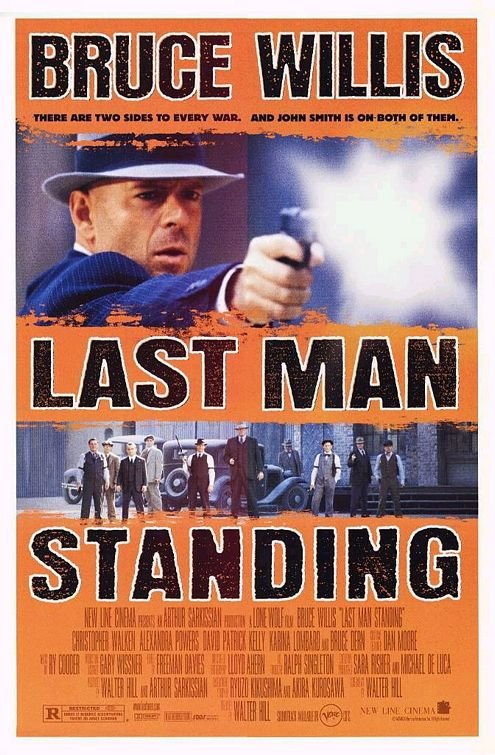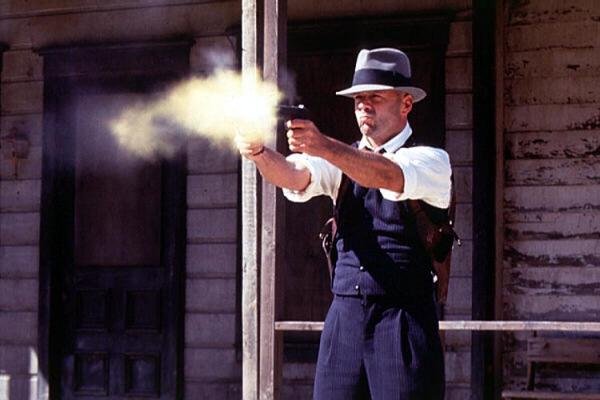LAST MAN STANDING: A Blood-Drenched Elegy For Cinematic Machismo
It's hard to find a good tough-guy movie nowadays. The blockbuster mentality that drives modern major-studio thinking just isn't interested in it. When action flicks that might have worked as tough-guy fare do pop up, they've had any potential rough edges sanded off in hopes of making said films as easily digestible to as many kinds of viewers as possible. Even worse, the action stars of old have been replaced with marketing-approved young faces that can bring in a broader, safer demographic (in other words, we won't be seeing a new Charles Bronson anytime soon). Tough-guy movies died out somewhere in the mid-1990's for a number of reasons in addition to the blockbuster mentality outlined above: rising budgets, the migration of viewer interest and the fact that a lot of tough-guy stars were trying to break into other genres to keep up with shifting demographics (remember the comedy phases that Schwazenegger and Stallone went through?). Bruce Willis was one of the last holdouts, as evidenced by his 1996 release Last Man Standing. At the time, it seemed like little more than a programmer. By modern standards, it plays like an elegy for tough-guy filmmaking.Walter Hill's screenplay uses Yojimbo for its template - even crediting the original writers in its credits - and mixes in spaghetti western and gangster flick motifs as it tells the story of loner/drifter/badass "John Smith" (Willis). Smith is on his way to Mexico when he stops in the Texas border town of Jericho. Always on the lookout for a few extra bucks, he quickly gets himself caught in the middle of a bootlegging war between an Italian gang led by Strozzi (Ned Eisenberg) and an Irish gang led by Doyle (David Patrick Kelly).In the best Yoji
Tough-guy movies died out somewhere in the mid-1990's for a number of reasons in addition to the blockbuster mentality outlined above: rising budgets, the migration of viewer interest and the fact that a lot of tough-guy stars were trying to break into other genres to keep up with shifting demographics (remember the comedy phases that Schwazenegger and Stallone went through?). Bruce Willis was one of the last holdouts, as evidenced by his 1996 release Last Man Standing. At the time, it seemed like little more than a programmer. By modern standards, it plays like an elegy for tough-guy filmmaking.Walter Hill's screenplay uses Yojimbo for its template - even crediting the original writers in its credits - and mixes in spaghetti western and gangster flick motifs as it tells the story of loner/drifter/badass "John Smith" (Willis). Smith is on his way to Mexico when he stops in the Texas border town of Jericho. Always on the lookout for a few extra bucks, he quickly gets himself caught in the middle of a bootlegging war between an Italian gang led by Strozzi (Ned Eisenberg) and an Irish gang led by Doyle (David Patrick Kelly).In the best Yoji mbo/A Fistful Of Dollars style, Smith plays both ends against the middle in hopes of a big score. Fate adds the requisite complications in the form of two trapped women - Doyle's enslaved, half-breed wife Felina (Karina Lombard) and Strozzi's mouthy moll Lucy (Alexandra Powers) - and Hickey (Christopher Walken), the grizzled button-man for Doyle who is instantly suspicious of Smith. It's inevitable that things won't end well or neatly for anyone involved and plenty of bullets and beatings splash across the screen before we reach the end credits.
mbo/A Fistful Of Dollars style, Smith plays both ends against the middle in hopes of a big score. Fate adds the requisite complications in the form of two trapped women - Doyle's enslaved, half-breed wife Felina (Karina Lombard) and Strozzi's mouthy moll Lucy (Alexandra Powers) - and Hickey (Christopher Walken), the grizzled button-man for Doyle who is instantly suspicious of Smith. It's inevitable that things won't end well or neatly for anyone involved and plenty of bullets and beatings splash across the screen before we reach the end credits. If you want to pick apart Last Man Standing, it's easy to do. It is neither as focused or precise as Yojimbo or A Fistful Of Dollars. It has a voiceover that is mostly superfluous and an underwhelming third act that chases its tail before ending in a hastily-staged sort of way that is odds with the elaborate buildup of its two preceding acts (word has it that the film's original coda was bloodier, meaner and more testosterone-drenched). Women will most likely hate it because the female characterizations are all paper-thin, either serving as madonnas or whores to suit the needs of its mucho-macho mindset.However, those caveats - legitimate as they might be - fall by the wayside if one looks at Last Man Standing as an exercise in tough-guy attitude. It's as hardboiled and un-p.c. as they come, delivering a steady stream of action setpieces intersp
If you want to pick apart Last Man Standing, it's easy to do. It is neither as focused or precise as Yojimbo or A Fistful Of Dollars. It has a voiceover that is mostly superfluous and an underwhelming third act that chases its tail before ending in a hastily-staged sort of way that is odds with the elaborate buildup of its two preceding acts (word has it that the film's original coda was bloodier, meaner and more testosterone-drenched). Women will most likely hate it because the female characterizations are all paper-thin, either serving as madonnas or whores to suit the needs of its mucho-macho mindset.However, those caveats - legitimate as they might be - fall by the wayside if one looks at Last Man Standing as an exercise in tough-guy attitude. It's as hardboiled and un-p.c. as they come, delivering a steady stream of action setpieces intersp ersed with tough talk so over the top it borders on the homoerotic. They really don't make 'em like this anymore, at least at the mainstream multiplex level, and fans of the form will be savoring every grizzled moment.Willis is a tremendous amount of fun to watch as he slugs shots of whiskey, delivers all his lines in a gruff whisper and fires off an arsenal's worth of bullets into anyone who crosses him (why use one bullet when you have a full clip?). Walken has a blast as Willis's nemesis and hams it up in his otherworldly Method-actor style: his best bit arrives when he responds to a bit of news he doesn't like by shooting up the room with a tommy gun. Eisenberg and Kelly do fine work as the hard-driving bosses, with Kelly being unexpectedly sympathetic as the lovelorn kingpin who doesn't understand that you can't blackmail a woman into loving you.
ersed with tough talk so over the top it borders on the homoerotic. They really don't make 'em like this anymore, at least at the mainstream multiplex level, and fans of the form will be savoring every grizzled moment.Willis is a tremendous amount of fun to watch as he slugs shots of whiskey, delivers all his lines in a gruff whisper and fires off an arsenal's worth of bullets into anyone who crosses him (why use one bullet when you have a full clip?). Walken has a blast as Willis's nemesis and hams it up in his otherworldly Method-actor style: his best bit arrives when he responds to a bit of news he doesn't like by shooting up the room with a tommy gun. Eisenberg and Kelly do fine work as the hard-driving bosses, with Kelly being unexpectedly sympathetic as the lovelorn kingpin who doesn't understand that you can't blackmail a woman into loving you. Elsewhere, Bruce Dern sleazes his way through a role as a corrupt sheriff and Wiliam Sanderson does his patented good-natured hillbilly routine as the town's barkeep -and look for a pre-Sopranos Michael Imperioli as Strozzi's hotheaded cousin. The women get less time and substance to work with but Lombard shows an ethereal grace as the story's "bird in a gilded cage" and Powers manages to wring a bit of sympathy from her role as a moll who is in over her head: her last scene is oddly moving. Fans of Judd Apatow's work will either be amused or horrified by the presence of his wife/regular actor Leslie Mann as a motor-mouthed hooker who gets thoroughly manhandled by the film's tough guys.
Elsewhere, Bruce Dern sleazes his way through a role as a corrupt sheriff and Wiliam Sanderson does his patented good-natured hillbilly routine as the town's barkeep -and look for a pre-Sopranos Michael Imperioli as Strozzi's hotheaded cousin. The women get less time and substance to work with but Lombard shows an ethereal grace as the story's "bird in a gilded cage" and Powers manages to wring a bit of sympathy from her role as a moll who is in over her head: her last scene is oddly moving. Fans of Judd Apatow's work will either be amused or horrified by the presence of his wife/regular actor Leslie Mann as a motor-mouthed hooker who gets thoroughly manhandled by the film's tough guys. However, the most important element of Last Man Standing is Walter Hill's direction. His script might be a bit ramshackle in parts but his work behind the camera is nothing short of stunning: he uses Lloyd Ahern's sharp photography to achieve a dusty, sunbleached look that matches its retro mood and choreographs the brutality with sadistic elan. A good example of his approach is an early scene where Smith squares off with one of Doyle's goons: he doesn't just put a bullet in him - he shoots the guy so many times that he does backwards somersaults out the saloon doors. It's also worth noting that this film has some of the loudest gunshots you'll ever hear in a film.In short, Last Man Standing is a lovably black-hearted throwback to the bad ol' days when men's men were allowed to slaughter their way across the silver screen with impunity. If only we knew how good we had it back then...
However, the most important element of Last Man Standing is Walter Hill's direction. His script might be a bit ramshackle in parts but his work behind the camera is nothing short of stunning: he uses Lloyd Ahern's sharp photography to achieve a dusty, sunbleached look that matches its retro mood and choreographs the brutality with sadistic elan. A good example of his approach is an early scene where Smith squares off with one of Doyle's goons: he doesn't just put a bullet in him - he shoots the guy so many times that he does backwards somersaults out the saloon doors. It's also worth noting that this film has some of the loudest gunshots you'll ever hear in a film.In short, Last Man Standing is a lovably black-hearted throwback to the bad ol' days when men's men were allowed to slaughter their way across the silver screen with impunity. If only we knew how good we had it back then...


